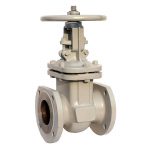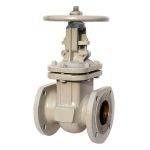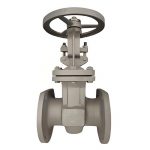TIANYU DN80-DN300 PN10-PN25 Russian Standard (GOST) Cast Steel Wedge Gate Valve: Durable Flanged Manual Flow Control Solution for Industrial & Municipal Pipelines
I. Product Overview
II. Key Attribute Specifications
A. Dimensional & Pressure-Temperature Parameters
- Nominal Diameter (Port Size): DN80 as the core specification, with a range of DN50 to DN300 (covering common Russian pipeline sizes). The full-bore design minimizes pressure drop, with a flow coefficient (Cv) ranging from 80 (DN80) to 500 (DN300), ensuring efficient media transfer. For example, a DN80 valve handles up to 120 m³/h of water at 20℃, meeting the flow demands of medium-scale industrial processes and municipal water distribution lines.
- Pressure Rating: PN10 (1.0MPa), PN16 (1.6MPa), and PN25 (2.5MPa)—aligning with Russian industrial pressure standards. Hydrostatic testing adheres to GOST 28099: 1.5×rated pressure for the valve shell (e.g., 3.75MPa for PN25) and 1.1×rated pressure for the seat (e.g., 2.75MPa for PN25), ensuring structural integrity and leak-tight performance under operating pressures.
- Temperature Range: -20℃ to 300℃, enabled by cast steel’s thermal stability and compatible sealing materials. This range covers ambient media (water, natural gas), moderately heated industrial fluids (hot oil, saturated steam), and low-temperature applications (chilled water in northern Russian regions).
B. Material Composition
- Valve Body & Bonnet:
- Cast Steel (25Г2С, GOST 19281): Russian standard carbon steel equivalent to international WCB, featuring tensile strength of 490–650MPa and yield strength ≥245MPa. It offers excellent resistance to thermal stress and mechanical impact, ideal for industrial and municipal applications. The surface is coated with anti-corrosive epoxy paint (GOST 9.402) for outdoor or buried installations, preventing rust in harsh climates.
- Optional Stainless Steel (08Х18Н10Т, GOST 5632): For corrosive media (e.g., seawater, chemical solutions), this 304-equivalent stainless steel provides enhanced corrosion resistance, meeting the needs of coastal or chemical processing projects.
- Wedge Gate:
- Cast Steel (25Г2С) with Nitriding Treatment: Hardens the surface (hardness ≥55 HRC) to reduce wear and improve sealing performance. The wedge angle (typically 5°–10°) ensures self-centering and tight contact with the seat.
- Stainless Steel (08Х18Н10Т): Optional for corrosive media, ensuring uniform corrosion resistance across critical sealing components.
- Valve Stem:
- Carbon Steel (40Х, GOST 4543): Heat-treated for strength, with precision threading and polishing to reduce friction. Equipped with an anti-blowout design (GOST 28099 requirement) to prevent stem ejection under pressure.
- Stainless Steel (08Х18Н10Т): Optional for corrosive environments, eliminating rust and ensuring smooth operation over long cycles.
- Sealing System:
- Soft Seal (EPDM/PTFE, GOST 24756): Standard for general service, EPDM resists water, steam, and mild chemicals (-20℃ to 150℃), while PTFE extends the range to 260℃ and enhances chemical inertness. Delivers ANSI/FCI Class VI leakage performance (bubble-tight sealing) for clean media like potable water.
- Metal Seal (Stellite 6 Surfacing, GOST 28099): Optional for high-temperature (≤300℃) or abrasive media (e.g., industrial wastewater with particles), with Stellite 6’s hardness (≥58 HRC) ensuring wear resistance and ANSI/FCI Class IV leakage performance.
- Handwheel:
- Cast Iron (HT200, GOST 1412): Ergonomic design with anti-slip grip, mounted via a brass nut for secure torque transmission.
C. Connection & Operational Features
- Connection Type: Flanged (RF, Raised Face), complying with GOST 12815 (Russian flange standard) and compatible with GOST 33259 pressure ratings. Flange drilling and dimensions match Russian pipeline systems, ensuring direct replacement of existing GOST-compliant valves. Optional GOST 28159 (welded flanges) for high-pressure PN25 applications.
- Operation Mode: Manual handwheel operation, with trapezoidal thread on the valve stem for smooth, backlash-free movement. The handwheel’s torque is optimized for each diameter—DN80 valves require ≤200 N·m, while DN300 PN25 valves require ≤800 N·m—enabling single-person operation without external power.
- Structural Features: Wedge gate design with flexible or rigid wedge options:
- Flexible Wedge: Split wedge with a slight gap, accommodating minor pipeline misalignment or thermal expansion—ideal for municipal water lines with temperature fluctuations.
- Rigid Wedge: Solid wedge for high-pressure PN25 applications, ensuring stability under heavy loads (e.g., industrial gas pipelines).
- Safety & Compliance Features: Valve position indicator (open/closed) for visual confirmation; lockable handwheel (optional) to prevent unauthorized operation; anti-corrosive fasteners (GOST 19904) for long-term reliability.
D. Certifications & Compliance
- Core Russian Standards: GOST 28099 (flanged gate valves for general industrial use), GOST 33259 (valve pressure-temperature ratings), GOST 12815 (flange dimensions), GOST 19281 (cast steel grades), GOST 24756 (rubber seals).
- Quality Certifications: ISO 9001 (quality management system), CE (for EU export), and Russian GOST R certification (mandatory for domestic projects).
- Testing Standards: GOST 28099 (hydrostatic and pneumatic testing), GOST 9.012 (non-destructive testing of cast components), ensuring compliance with Russian safety and performance requirements.
III. Feature Description
A. Russian Standard (GOST) Compliance: Seamless Integration into Local Projects
B. Wedge Gate Design: Reliable Sealing Under Pressure Fluctuations
C. Cast Steel (25Г2С) Construction: Durability in Harsh Environments
- Temperature Resistance: Performs reliably from -20℃ (typical winter lows in central Russia) to 300℃ (high-temperature industrial steam), avoiding brittle fracture in cold weather or deformation in heat.
- Mechanical Strength: Withstands mechanical impact and pressure fluctuations, common in industrial pipelines handling oil or gas. In metallurgical plants, the cast steel body resists vibration from heavy machinery, maintaining structural integrity over years of use.
- Corrosion Resistance: Epoxy coating (GOST 9.402) protects against rust in outdoor or buried installations, while optional 08Х18Н10Т stainless steel extends corrosion resistance to chloride-rich media (e.g., seawater in Baltic coastal projects).
D. Manual Handwheel Operation: Cost-Effective & Reliable
- Remote locations without power access (e.g., rural water supply lines in Siberia, oil well sites in Western Siberia).
- Low-frequency operation scenarios (e.g., pipeline maintenance isolation, seasonal flow adjustment in irrigation systems).
- Budget-sensitive municipal projects (e.g., small-town water treatment plants).
E. Flanged Connection: Easy Installation & Maintenance
- Leak-Tight Integrity: The raised face (RF) flange and graphite-reinforced gasket create a robust seal, even under vibration or pressure fluctuations. In oil refineries, this design has maintained zero leakage for 5+ years, outperforming threaded connections that require frequent tightening.
- Simplified Maintenance: Flanges allow the valve to be removed from the pipeline without cutting, reducing downtime by 70% compared to welded valves. For example, replacing a worn soft seal in a DN80 valve takes 1–2 hours with flanged connections, versus 4–6 hours for welded valves.
- Compatibility: GOST 12815 flanges match existing Russian pipeline components, enabling easy retrofitting. A Moscow municipal project, for instance, replaced aging cast iron valves with TIANYU’s DN100 model without modifying pipeline flanges, saving time and costs.


IV. Manufacturing Processes
A. Material Inspection & Preparation
- Raw Material Verification: All materials comply with Russian GOST standards:
- 25Г2С cast steel billets undergo spectral analysis (GOST 19281) to confirm chemical composition (C: 0.22–0.30%, Mn: 1.00–1.50%) and ultrasonic testing (UT, GOST 9.012) to detect internal defects (porosity, cracks).
- 08Х18Н10Т stainless steel is verified via positive material identification (PMI) to ensure chromium (17–19%) and nickel (8–11%) content, meeting corrosion resistance requirements.
- EPDM/PTFE seals are tested to GOST 24756 for compression set, tensile strength, and temperature resistance, ensuring compatibility with the valve’s operating range.
- Surface Preparation:
- Cast components (body, bonnet, gate) are sandblasted (GOST 9.304) to remove scale and surface defects, improving paint adhesion.
- Valve stems are heat-treated (quenching and tempering) to enhance strength, then polished to a surface roughness of Ra ≤1.6μm to reduce friction with packing.
- Flange faces are machined to flatness tolerance ≤0.05mm/m (GOST 12815) and surface finish Ra ≤3.2μm for proper gasket seating.
B. Precision Machining of Critical Components
- Valve Body & Bonnet: CNC turning and milling centers shape the body and bonnet, with internal seat surfaces honed to a diameter tolerance of H7 (0–+0.03mm) to ensure uniform contact with the wedge gate. Flange drilling is performed using CNC drilling machines, matching GOST 12815 dimensions with a tolerance of ±0.1mm.
- Wedge Gate: The gate is CNC-turned to precise wedge angles (5°–10°) and lapped to a surface roughness of Ra ≤0.8μm. For metal-sealed valves, Stellite 6 is welded to the gate’s sealing face via TIG welding (GOST 26011), then ground to a uniform thickness of 1.5–2.0mm.
- Valve Stem: Threading (trapezoidal, GOST 9150) is performed via thread rolling for wear resistance, with a thread pitch optimized for smooth operation. The stem’s upper end is machined to fit the handwheel nut, ensuring secure torque transmission.
C. Assembly & Sealing Integration
- Seal Installation: Soft seals (EPDM/PTFE) are precision-cut to match the seat’s profile and press-fitted into the valve body, with retaining rings to prevent displacement during operation. Metal seals are lapped with the gate to ensure uniform contact, achieving ANSI/FCI Class IV leakage performance.
- Valve Stem & Handwheel Assembly: The stem is inserted through the bonnet, with graphite-impregnated PTFE packing (GOST 24756) installed to prevent media leakage. The handwheel is mounted via a brass nut, with a cotter pin (GOST 13994) to secure it against rotation.
- Final Alignment: The gate is adjusted to ensure 0.1–0.2mm preload against the seat, and the stem’s axial runout is tested to ≤0.05mm to avoid binding during operation.
D. Quality Testing & GOST Certification
- Hydrostatic Testing:
- Shell Test: The valve body is filled with water and pressurized to 1.5×rated pressure (e.g., 3.75MPa for PN25) for 30 minutes (GOST 28099). No leakage, sweating, or deformation is allowed—test results are documented in a hydrostatic test report.
- Seat Test: The valve is closed, and water is pressurized to 1.1×rated pressure (e.g., 2.75MPa for PN25) on the inlet side. Leakage is measured via a flow meter: ≤0.1×DN mm³/min for soft seals (ANSI Class VI) and ≤0.01% of rated flow for metal seals (ANSI Class IV).
- Operational Testing: The valve undergoes 100 open-close cycles to verify smooth operation, with torque measured at each cycle (variation ≤5%). The handwheel is tested to ensure it can fully open/close the valve within 10–15 turns (DN80) to 30–40 turns (DN300).
- Non-Destructive Testing (NDT): Cast components are inspected via magnetic particle testing (MPI, GOST 9.072) to detect surface cracks, ensuring structural integrity.
- GOST Certification: Final inspection includes verification of dimensional compliance (GOST 12815, GOST 28099) and compilation of certification documents (GOST R certificate, material test reports, test records) for delivery.
V. Product Advantages
A. GOST Compliance: Streamlined Project Approval
B. Durability in Extreme Conditions
C. Cost-Effective & Low Maintenance
- Upfront costs are 30–40% lower than automated valves, with no need for wiring, actuators, or power supply.
- Maintenance requirements are minimal—only annual lubrication of the stem packing and visual inspection—saving labor costs in remote locations.
- Replaceable seals and modular components lower repair costs: a worn PTFE seal costs 10–15% of the valve’s total price, versus 30–40% for non-modular designs.
D. Reliable Sealing & Safety
E. Versatility Across Industries
- Municipal water supply: DN80-DN200 PN10 valves with EPDM seals handle potable water, complying with SanPiN (Russian hygiene standards).
- Oil and gas: DN100-DN300 PN25 valves with metal seals regulate crude oil and natural gas flow in Western Siberian fields.
- Power generation: DN150-DN250 PN25 valves with PTFE seals control steam flow in coal-fired power plants.
VI. Product Applications
A. Municipal Water Supply & Drainage
- Water Distribution Networks: DN80-DN200 PN10 valves control flow in urban water mains (e.g., St. Petersburg’s water grid). GOST 12815 flanges match existing pipelines, and EPDM seals ensure potable water quality (SanPiN 2.1.4.1110-02). The flexible wedge design accommodates ground settlement in urban areas, maintaining sealing integrity.
- Wastewater Treatment Plants: DN100-DN300 PN16 valves regulate flow in sewage collection and treatment lines. 25Г2С cast steel resists corrosion from organic matter, while PTFE seals withstand chlorine-based disinfectants—common in Russian wastewater facilities.
B. Oil & Gas Industry
- Crude Oil Pipelines: DN150-DN300 PN25 valves with metal seals control crude oil flow in Western Siberian and Volga-Ural oil fields. The rigid wedge design handles high pressure (PN25), and GOST compliance ensures compatibility with Russian-made pipeline equipment. Manual operation is ideal for remote well sites without power.
- Natural Gas Distribution: DN80-DN150 PN16 valves regulate natural gas flow in municipal and industrial gas lines. The cast steel body resists corrosion from moisture in gas, and the wedge gate’s tight sealing prevents gas leakage—critical for safety in residential areas.
C. Power Generation
- Coal-Fired Power Plants: DN150-DN250 PN25 valves with PTFE seals control steam and cooling water flow in boiler auxiliary systems. 25Г2С cast steel withstands high temperatures (≤300℃), and the valve’s low pressure drop reduces pump energy consumption—important for cost-sensitive power plants.
- Hydroelectric Power Plants: DN200-DN300 PN10 valves regulate water flow in turbine cooling systems. The flexible wedge design adapts to thermal expansion, and GOST 12815 flanges match hydroelectric pipeline components.
D. Metallurgy & Manufacturing
- Steel Mills: DN100-DN200 PN25 valves control cooling water and compressed air flow in blast furnaces. 25Г2С cast steel resists vibration and high temperatures, while metal seals withstand abrasive particles in cooling water—common in Russian steel plants (e.g., Magnitogorsk Iron and Steel Works).
- Chemical Plants: DN80-DN150 PN16 valves with 08Х18Н10Т stainless steel bodies handle mild chemicals (e.g., dilute acids, alkalis). PTFE seals’ chemical inertness prevents media contamination, and GOST compliance meets Russian chemical industry safety standards (GOST 12.1.007).
E. Construction & Infrastructure
- Commercial Buildings: DN80-DN100 PN10 valves control hot and cold water flow in large office buildings, shopping malls, and hotels (e.g., in Moscow and Kazan). Compact design saves space in mechanical rooms, and manual operation simplifies maintenance.
- Industrial Facilities: DN150-DN300 PN25 valves regulate water, oil, and gas flow in manufacturing plants (e.g., automotive, electronics). The valve’s durability ensures reliable operation in 24/7 production environments.
RELATED
-

DN50-DN400 PN10/PN16 Pneumatic Through Conduit Knife Gate Valve Applied to Slurry Conveying Pipelines
TIANYU DN50-DN400 PN10/PN16 Pneumatic Through Conduit Knife Gate Valve: Abrasive-Resistant Ductile Iron/Stainless Steel Flow Control Solution for Meta…
GATE VALVE 10/22/2025 -

Heavy-duty Abrasive-Resistant Industrial Knife Gate Valves With Petroleum Equipment Zero Leakage Slurry Valve
TIANYU Heavy-Duty Industrial Knife Gate Valve: Abrasive-Resistant Cast Steel/Stainless Steel Valve with Sharp Blade Gate for Slurry, Solid-Laden Media…
GATE VALVE 10/22/2025 -

DIN/ASME/API DN100 Electric Knife Gate Valve with WCB Wafer Flange for Water Control in Gas Media Applications
DN100 (4in) Electric Knife Gate Valve with WCB Wafer Flange for Water, Gas, Dust and Particle Media Control I. Product Overview TIANYU DN100 (4in) ele…
GATE VALVE 09/20/2025 -

4inch Stainless Steel Flanged Low Pressure Knife Gate Valve Driven by Electric Actuator
Stainless Steel Flanged Knife Gate Valve with Electric Actuator for Slurry, Wastewater, and Industrial Solid-Laden Media Control I. Product Overview T…
GATE VALVE 09/12/2025 -

DN50 Ductile Iron Metal-Seated Flanged Connection Telescopic Soft Seal Mechanical Gate Valve
I. Product Overview TIANYU DN50 ductile iron metal-seated flanged connection telescopic soft seal mechanical gate valve is a precision-engineered indu…
GATE VALVE 09/11/2025 -

DN100 Double Disc Gate Valve Pneumatic Parallel Sliding Double Disc Ceramic Gate Valve
Specification TIANYU Pneumatic Parallel Sliding Double Disc Ceramic Gate Valve I. Product Overview TIANYU pneumatic parallel sliding double disc ceram…
GATE VALVE 09/06/2025






